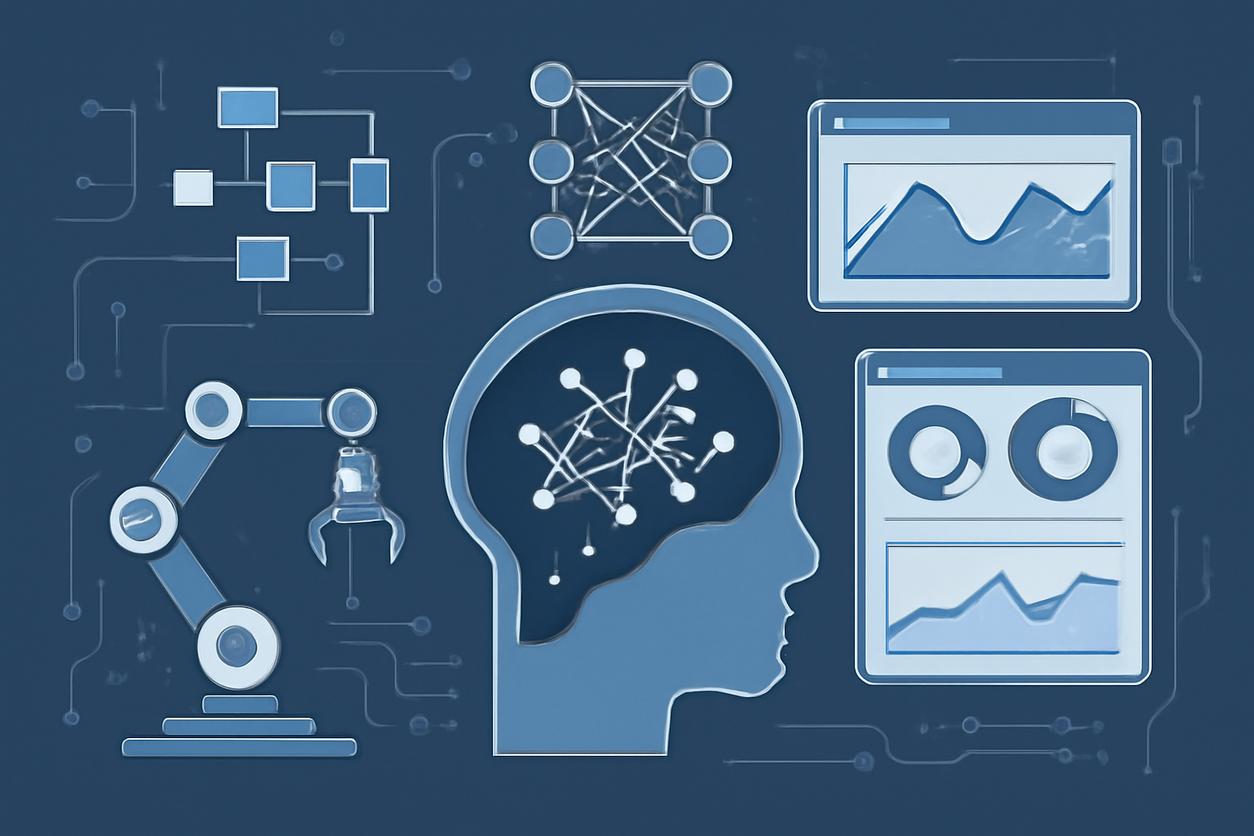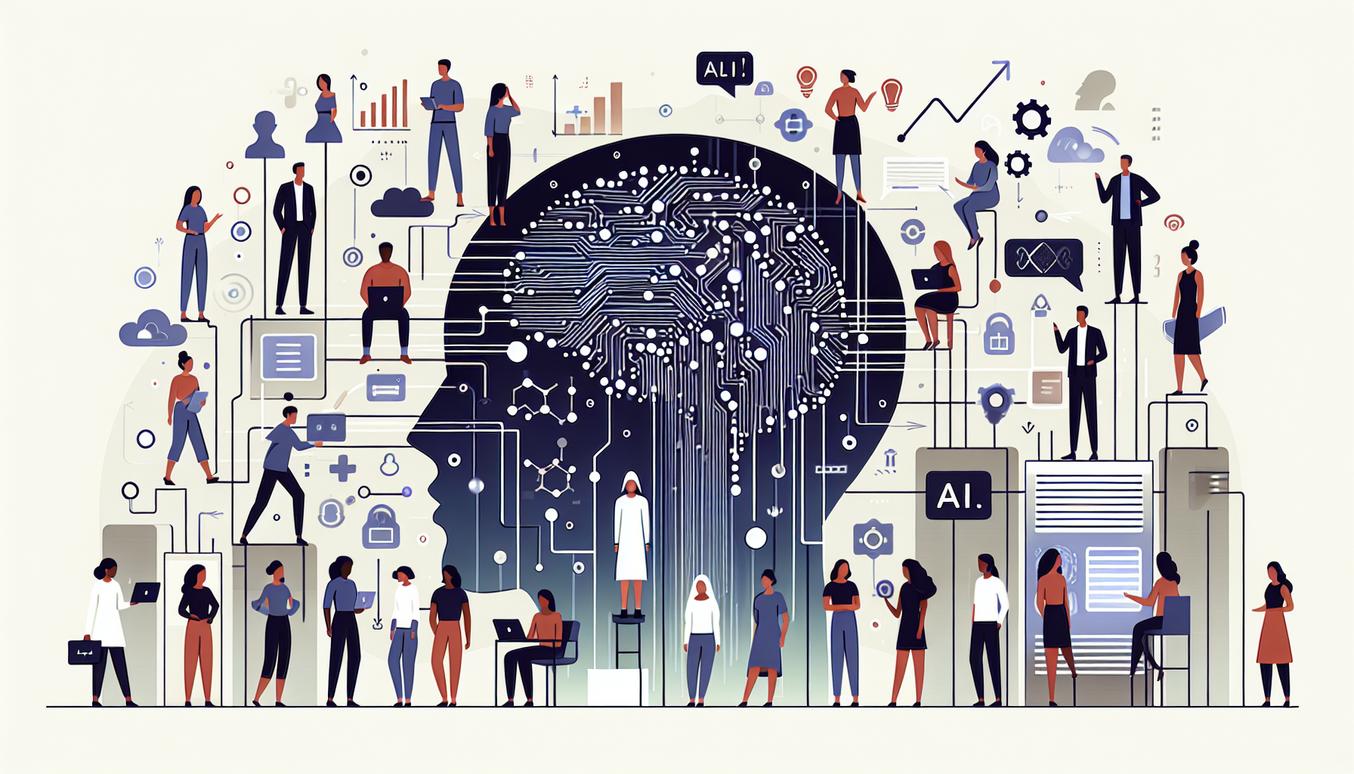AI-Powered Automation: The Definitive Guide for Technical Leaders in 2025
Table of Contents
- Introduction: Reframing Automation with Intelligent Systems
- Core Concepts: Neural Architectures and Automation Patterns
- Design Patterns for AI-Powered Automation
- Data Foundations: Quality, Labeling, and Pipeline Strategies
- Integration: Orchestration, APIs, and Interoperability
- Governance: Responsible AI, Security, and Compliance
- Case Patterns: Templates for Finance, Healthcare, and Operations
- Measuring Success: KPIs, Observability, and Validation
- Implementation Roadmap: Pilot to Production at Scale
- Common Pitfalls and Mitigation Strategies
- Further Reading and Resource Annotations
- Appendix: Checklists and Sample Architecture Diagrams
Introduction: Reframing Automation with Intelligent Systems
For decades, automation has been synonymous with rigid, rule-based systems executing predefined tasks. While effective for repetitive processes, this traditional approach lacks the flexibility to handle ambiguity, variability, and complex decision-making. Enter AI-Powered Automation, a paradigm shift that infuses automation with cognitive capabilities. Instead of just following scripts, these intelligent systems learn from data, adapt to new scenarios, and make predictions to automate tasks that were once exclusively in the human domain.
This evolution moves beyond simple robotic process automation (RPA) into a realm of intelligent process automation (IPA) and cognitive automation. For product managers, technical leads, and innovation strategists, understanding the principles of **AI-Powered Automation** is no longer a forward-thinking exercise; it is a strategic imperative for building resilient, efficient, and intelligent enterprise systems for 2025 and beyond.
Core Concepts: Neural Architectures and Automation Patterns
At the heart of **AI-Powered Automation** are sophisticated machine learning models capable of pattern recognition, prediction, and generation. Understanding their foundational concepts is key to designing effective automation solutions.
Understanding Neural Architectures
The core engine for many advanced AI systems is the artificial neural network. Inspired by the human brain, these are complex mathematical structures that learn to identify patterns in vast datasets. A deep dive into Neural Networks reveals various architectures (like CNNs for image data or Transformers for text) tailored to specific tasks, from recognizing invoice details to predicting supply chain disruptions. This ability to learn from examples, rather than being explicitly programmed, is what separates intelligent automation from its predecessors.
Key Automation Paradigms
Different problems require different AI approaches. The most relevant paradigms for automation include:
- Supervised Learning: The most common approach, where a model learns from labeled data to make predictions. This is the foundation for classification (e.g., spam filtering) and regression (e.g., demand forecasting) tasks.
- Unsupervised Learning: Used when data is unlabeled. The model finds hidden patterns or structures on its own, ideal for customer segmentation or anomaly detection in cybersecurity.
- Reinforcement Learning: This paradigm involves an AI agent learning to make optimal decisions through trial and error to maximize a reward. As detailed in the principles of Reinforcement Learning, it is exceptionally powerful for dynamic optimization problems like inventory management or algorithmic trading.
- Natural Language Processing (NLP): A field of AI focused on enabling computers to understand, interpret, and generate human language. Leveraging Natural Language Processing is crucial for automating tasks involving unstructured text, such as customer support ticket routing, contract analysis, and sentiment analysis.
Design Patterns for AI-Powered Automation
Implementing **AI-Powered Automation** is not a one-size-fits-all process. Effective solutions are built using established design patterns that balance computational intelligence with practical business needs.
Human-in-the-Loop (HITL)
This pattern integrates human oversight into the automation workflow, especially for critical or low-confidence decisions. The AI handles the bulk of the work but flags exceptions for human review. This is essential in fields like medical diagnostics, where an AI might pre-screen images but a radiologist provides the final confirmation. It builds trust and provides a mechanism for continuous model improvement through feedback.
Predictive Automation
This pattern uses AI models to forecast future events and trigger automated actions based on those predictions. For example, a predictive maintenance system analyzes sensor data from machinery, predicts a potential failure, and automatically schedules a maintenance ticket and orders the necessary parts before a breakdown occurs.
Generative Automation
Powered by large language models (LLMs) and other generative AI, this pattern focuses on creating new content. It can be used to automatically generate marketing copy, write code snippets, synthesize reports from raw data, or create personalized customer email responses, dramatically increasing the productivity of creative and technical teams.
Data Foundations: Quality, Labeling, and Pipeline Strategies
An **AI-Powered Automation** system is only as reliable as the data it is trained on. A robust data foundation is the most critical and often underestimated component of any AI initiative.
The Primacy of Data Quality
Garbage in, garbage out. Poor data quality—including missing values, inaccuracies, and inconsistencies—will lead to biased or ineffective automation. Establishing a data governance framework that ensures data is accurate, complete, and consistent is the first step. This involves data cleaning, validation rules, and ongoing monitoring.
Effective Labeling Strategies
For supervised learning, high-quality data labels are non-negotiable. Whether performed in-house or outsourced, the labeling process must be consistent and guided by clear criteria. Techniques like active learning can help prioritize which data points to label, optimizing the use of human resources and improving model performance more efficiently.
Building Robust Data Pipelines
Automated systems require a continuous flow of clean, processed data. A well-architected data pipeline (ETL/ELT) is essential for ingesting data from various sources, transforming it into a usable format, and feeding it to machine learning models for both training and real-time inference. These pipelines must be scalable, reliable, and observable.
Integration: Orchestration, APIs, and Interoperability
AI models do not operate in a vacuum. Their value is realized when they are integrated into existing business processes and enterprise systems. This requires a thoughtful approach to orchestration and interoperability.
Orchestration Engines
An orchestration engine (like Apache Airflow, Kubeflow, or commercial MLOps platforms) manages the end-to-end lifecycle of an AI model. It automates the entire workflow, from data ingestion and model training to deployment, monitoring, and retraining, ensuring the **AI-Powered Automation** solution runs smoothly and efficiently.
The Role of APIs
Application Programming Interfaces (APIs) are the connective tissue that allows AI services to communicate with other software. A predictive model, for instance, can be exposed as a REST API. When a CRM system needs a customer churn prediction, it sends the customer’s data to the API endpoint and receives a probability score in return, seamlessly integrating intelligence into the existing application.
Governance: Responsible AI, Security, and Compliance
As **AI-Powered Automation** becomes more prevalent, establishing strong governance is critical to manage risks, ensure fairness, and maintain trust.
Frameworks for Responsible AI
Adopting a structured approach to AI ethics and safety is essential. Frameworks like the NIST AI Risk Management Framework provide guidance on governing, mapping, measuring, and managing AI risks. This includes addressing issues like model bias, transparency, and explainability (XAI), ensuring that automated decisions are fair and can be understood by stakeholders.
Security Considerations
AI systems introduce new security vulnerabilities. These include adversarial attacks (malicious inputs designed to fool a model), data poisoning, and model theft. A comprehensive security strategy for **AI-Powered Automation** must include protecting the data pipeline, securing API endpoints, and continuously monitoring for anomalous model behavior.
Compliance and Auditing in 2025 and Beyond
With regulations around data privacy (like GDPR) and upcoming AI-specific legislation, automated systems must be designed for compliance. This means maintaining detailed logs of model predictions and data lineage to support audits. The principles of AI Safety emphasize building robust and beneficial systems, which inherently aligns with long-term compliance goals.
Case Patterns: Templates for Finance, Healthcare, and Operations
The application of **AI-Powered Automation** varies by industry. The following table provides templates for common use cases.
| Industry | Use Case | AI Model Type | Key Metrics |
|---|---|---|---|
| Finance | Automated Loan Underwriting | Classification, Gradient Boosting | Default Rate, Approval Accuracy, Bias Metrics |
| Healthcare | Patient Triage and Symptom Checking | Natural Language Processing, Decision Tree | Triage Accuracy, Patient Wait Time, Escalation Rate |
| Operations | Intelligent Document Processing (IDP) | Optical Character Recognition (OCR), NLP | Extraction Accuracy, Documents Processed Per Hour |
| Retail | Dynamic Pricing Optimization | Reinforcement Learning, Time-Series Forecasting | Revenue Uplift, Conversion Rate, Profit Margin |
Measuring Success: KPIs, Observability, and Validation
The impact of **AI-Powered Automation** must be quantifiable. Success requires moving beyond model accuracy to business-centric metrics.
Defining Key Performance Indicators (KPIs)
Technical metrics like precision and recall are important, but business KPIs are what ultimately matter. These could include:
- Efficiency Gains: Reduction in manual hours, cost per transaction, or process cycle time.
- Revenue Impact: Increase in sales, customer lifetime value, or lead conversion rates.
- Risk Reduction: Decrease in fraud incidents, compliance breaches, or operational errors.
The Importance of Observability
Observability in AI systems means having a complete view of their performance in production. This involves monitoring not just system health (latency, throughput) but also data drift (changes in input data distribution) and concept drift (changes in the underlying patterns the model learned). Full observability allows teams to proactively detect and diagnose issues before they impact the business.
Continuous Validation and Model Drift
A model that was accurate during training can degrade over time due to model drift. A robust **AI-Powered Automation** strategy includes continuous validation, where the model’s performance is regularly tested against a holdout dataset or live results. When performance drops below a certain threshold, an automated retraining pipeline should be triggered.
Implementation Roadmap: A Phased Approach for 2025
Deploying **AI-Powered Automation** at scale requires a structured, iterative approach. A phased roadmap minimizes risk and maximizes the chances of success.
- Phase 1: Pilot and Proof-of-Concept (PoC). Start with a well-defined, high-impact business problem. The goal is not to build a perfect system, but to demonstrate the technical feasibility and potential business value of an AI automation solution quickly.
- Phase 2: Minimum Viable Product (MVP). Develop an end-to-end version of the solution with core features. Integrate it into a limited part of the business workflow to gather real-world feedback and performance data. Focus on creating a stable, reliable system.
- Phase 3: Scaling to Production. Based on the success of the MVP, enhance the solution with more features, improve its robustness, and scale the infrastructure. Gradually roll it out across the organization, accompanied by proper training and change management.
Common Pitfalls and Mitigation Strategies
Many AI projects fail to deliver on their promise. Awareness of common pitfalls can help teams navigate the complexities of implementation.
Ignoring Data Governance
Pitfall: Starting model development with poor quality data, leading to wasted effort and unreliable results.Mitigation: Establish a data governance council and invest in data quality tools and processes *before* launching major AI initiatives.
Lack of a Clear Business Case
Pitfall: Pursuing AI for its own sake without a clear link to a business problem or measurable outcome.Mitigation: Every **AI-Powered Automation** project must start with a business case that defines the problem, the proposed solution, and the KPIs for success.
Underestimating Change Management
Pitfall: Deploying a new automation system without preparing the human workforce, leading to resistance and low adoption.Mitigation: Involve end-users early in the design process. Communicate transparently about how the technology will augment their roles, not replace them, and provide comprehensive training.
Further Reading and Resource Annotations
To deepen your understanding of **AI-Powered Automation**, we recommend the following resources:
- Artificial Neural Networks: A comprehensive technical overview of the foundational architectures that power deep learning and modern AI.
- Reinforcement Learning: An excellent introduction to the concepts of agents, environments, and rewards for building self-optimizing systems.
- Natural Language Processing: A detailed summary of the techniques used to enable machines to process and understand human language.
- NIST AI Risk Management Framework: An official, actionable framework from the U.S. National Institute of Standards and Technology for managing the risks associated with AI systems.
- AI Safety: An essential overview of the research and practices aimed at ensuring advanced AI systems are beneficial and do not cause harm.
Appendix: Checklists and Sample Architecture Diagrams
AI Project Readiness Checklist
- Business Alignment: Is there a clear, measurable business problem to solve?
- Data Availability: Do we have access to sufficient, relevant, and high-quality data?
- Technical Expertise: Does the team have the necessary skills in data science, ML engineering, and software development?
- Infrastructure: Is the required computing and data storage infrastructure in place or planned?
- Governance and Ethics: Have we considered the ethical implications, potential biases, and compliance requirements?
- Stakeholder Buy-In: Do we have support from both executive leadership and the end-users who will be impacted?
Sample High-Level Architecture (Text Description)
A typical **AI-Powered Automation** architecture consists of several layers. The Data Ingestion Layer collects data from various sources (e.g., databases, APIs, event streams) and places it in a central data lake or warehouse. The Data Processing Layer runs ETL/ELT jobs to clean, transform, and feature-engineer the raw data. The Model Training and Management Layer, often part of an MLOps platform, uses this processed data to train models, version them in a model registry, and store them. Finally, the Inference and Application Layer deploys the trained model as an API service. An orchestration engine coordinates workflows across all layers, while a dedicated monitoring service provides observability into the system’s health and performance.









